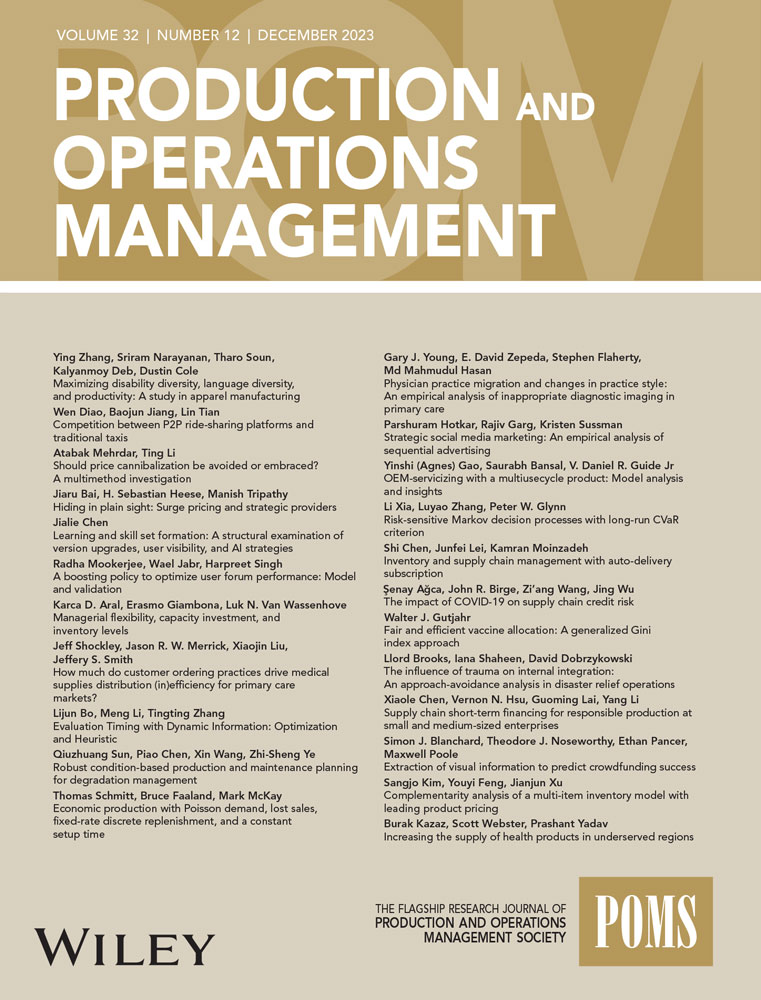EXPRESS: Pricing and Capacity Design for Profit-driven and Welfare-driven Healthcare Providers
IF 4.8
3区 管理学
Q1 ENGINEERING, MANUFACTURING
引用次数: 0
Abstract
In choosing healthcare services, price and waiting time are two important factors that matter to patients. Price is set by healthcare providers, while waiting time is usually endogenously determined by patient choice and the healthcare provider’s capacity investment. We study the pricing and capacity design for profit-driven hospitals offering two types of healthcare services—regular and premium—serving heterogeneous patients who choose from either of the two types of services. Patients make their choices based on both price and endogenously determined equilibrium waiting time. We then benchmark profit-driven hospitals to welfare-driven hospitals to reveal how the behaviors of for-profit hospitals deviate from the socially optimal outcomes in patients waiting, service capacity, and price. We find that fewer patients are treated by premium services in profit-driven hospitals, and thus profit-driven hospitals invest less in premium service capacity and charge a higher premium for premium services than welfare-driven hospitals. These inefficiency distortions exist in profit-driven hospitals primarily because they are incentivized to differentiate between the waiting times of the two types of service to induce patients to pay a higher premium for premium services. Our results also show that if the inefficiency in patient partition is corrected, profit-driven hospitals would choose the welfare-maximizing level of premium service capacity and thus achieve socially optimal results. However, we also find that regulations such as price ceiling and capacity regulation cannot fully correct the inefficiency in patient partition and capacity decisions of profit-driven hospitals. Lastly, the model is extended in several ways to ensure robustness.快讯:利润驱动型和福利驱动型医疗服务提供商的定价和能力设计
在选择医疗服务时,价格和等候时间是患者关心的两个重要因素。价格由医疗机构制定,而等待时间通常由患者的选择和医疗机构的能力投资内生决定。我们研究了以盈利为导向的医院的定价和产能设计,这些医院提供两种类型的医疗服务--普通服务和优质服务--为异质患者提供服务,患者可从这两种服务中任选其一。患者根据价格和内生决定的均衡等待时间做出选择。然后,我们将盈利驱动型医院与福利驱动型医院进行比较,以揭示盈利医院的行为在患者等候、服务能力和价格方面是如何偏离社会最优结果的。我们发现,与福利驱动型医院相比,营利驱动型医院中接受优质服务治疗的病人更少,因此营利驱动型医院对优质服务能力的投资更少,对优质服务收取的溢价更高。利润驱动型医院之所以存在这些低效率扭曲现象,主要是因为它们有动力区分两类服务的等待时间,以诱导患者为优质服务支付更高的溢价。我们的结果还表明,如果病人分区的低效率得到纠正,利润驱动型医院将选择福利最大化的溢价服务能力水平,从而实现社会最优结果。然而,我们也发现,价格上限和产能监管等法规并不能完全纠正利润驱动型医院在患者分流和产能决策方面的低效率。最后,为了确保模型的稳健性,我们对模型进行了多方面的扩展。
本文章由计算机程序翻译,如有差异,请以英文原文为准。
求助全文
约1分钟内获得全文
求助全文
来源期刊

Production and Operations Management
管理科学-工程:制造
CiteScore
7.50
自引率
16.00%
发文量
278
审稿时长
24 months
期刊介绍:
The mission of Production and Operations Management is to serve as the flagship research journal in operations management in manufacturing and services. The journal publishes scientific research into the problems, interest, and concerns of managers who manage product and process design, operations, and supply chains. It covers all topics in product and process design, operations, and supply chain management and welcomes papers using any research paradigm.
 求助内容:
求助内容: 应助结果提醒方式:
应助结果提醒方式:


